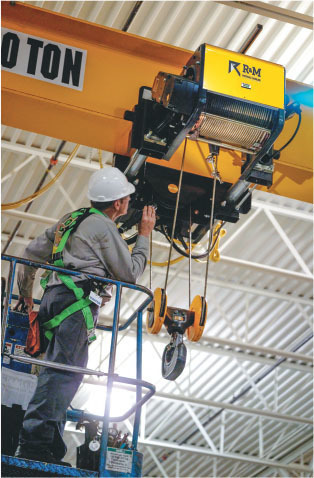Safer Handling
BY TOM GRESHAM
The hoist equipment that falls under the umbrella of the Hoist Manufacturers Institute, an independent trade association affiliated with MHI, covers a wide spectrum of lifting needs—from smaller hoists with capacities of up to two tons to higher-capacity hoists that can lift up to 250 tons and above. Still, no matter the lifting requirements, the training of the workers who man the hoists is crucial to a safe environment.
“Obviously, in our industry, there’s a big focus on the training of operators,” said Keith Butler, president of HMI and national sales manager for MHI member Piedmont Hoist and Crane.
That’s why providing extensive training materials and opportunities has been a top priority of the HMI group in recent years. HMI has developed extensive safety guidelines and worked hard to make them more readily accessible. That includes not only publishing them on the HMI website and providing them to hoist customers but partnering with OSHA to create and share content together. In addition, HMI has encouraged its member companies to post the guidelines on their individual sites.
“We’re just trying to make it as easy as possible for the manufacturers who use our equipment to be able to refer to those materials and make it straightforward to onboard new talent,” said Rob Beightol, vice president of HMI and director of marketing for MHI member Gorbel.
Lower-capacity hoists frequently are used in large numbers in one facility by operators, requiring many workers to be trained on them. Large-capacity hoists on large cranes, meanwhile, only need one or two workers to be trained and certified to operate them, leading to fewer labor shortage concerns. Beightol said the recent difficulties that manufacturers who use lower-capacity hoists have had in finding qualified workers has made training especially time-consuming.
As a result, he said, “we’ve seen a lot more requests for training materials and specifications. And, at times, HMI members are getting requests to go on site to produce training sessions.”
No matter the scale of the lifting, Beightol said HMI members aim to use a consultative approach with users of their equipment, trying to understand their specific challenges and objectives.
Click here to read the full article.
Photo provided by Gorbel.
 MHI Solutions Improving Supply Chain Performance
MHI Solutions Improving Supply Chain Performance
